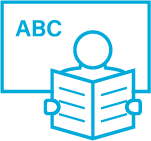Examining the Simple View of Reading in a Transparent Orthography: A Longitudinal Study from Kindergarten to Grade 3

The main finding of the present study was that cognitive skills predicted reading comprehension mainly indirectly via listening comprehension and reading fluency in grade 1.
Authors: Minna Torppa, George K. Georgiou, Marja-Kristiina Lerkkanen, Pekka Niemi, Anna-Maija Poikkeus, & Jari-Erik Nurmi
Source: Torppa M., Georgiou, G. K., Lerkkanen, M-K., Niemi, P., Poikkeus, A-M., & Nurmi, J-E. (2016). Examining the Simple View of Reading in a Transparent Orthography: A Longitudinal Study from Kindergarten to Grade 3. Merrill-Palmer Quarterly, 62(2), 179–206. https://muse.jhu.edu/article/621824
In this study, the dynamic relationships between components of the simple view of reading (SVR) were examined in a transparent orthography, together with the predictive value of cognitive skills (phonological awareness, letter knowledge, rapid naming, and vocabulary) on SVR components. Cognitive skills predicted reading comprehension mainly indirectly via listening comprehension and reading fluency in grade 1.
- Becoming a skilled reader with the ability to decode and comprehend written language is an important prerequisite for full participation in modern society.
- According to the SVR, reading comprehension is the product of an efficient decoding ability and linguistic comprehension, which together account for a significant degree of variance in reading comprehension.
- Although decoding and reading comprehension correlate, factor analytic approaches have demonstrated that decoding and linguistic comprehension load on separate factors; thus, they form distinct constructs and have been shown to be influenced by partially independent genetic components.
- Because of the fast learning curve in reading accuracy, the examination of SVR in a transparent orthography offers an interesting point of departure for discussing the role of reading fluency, which can be a more sensitive measure of decoding than accuracy.
- In transparent orthographies, the effect of listening comprehension on reading comprehension appears to be stronger than that of decoding.
What are phonological awareness and letter knowledge?
- Difficulty with processing speech sounds (such as identifying phonemes within words) or letters hinders the development of basic decoding, requiring speech sounds to be mapped to letters, which makes sequences of grapheme-phoneme connections.
What is rapid naming?
- This requires the rapid sequential naming of familiar items, which is analogous with fluent reading.

The study
In this study, the aim was to extend previous studies by including pre-literacy skills as predictors of SVR components.
Research questions:
- What are the longitudinal relationships between listening comprehension, reading fluency, and reading comprehension in grades 1–3?
- To what extent do preschool-age cognitive skills (letter knowledge, phonological awareness, rapid naming, and vocabulary) predict reading in grades 1–3?
Participants were 1815 kindergarten-aged children and their teachers from three medium-sized towns and one municipality in Finland. Compulsory education begins in the year of the child’s seventh birthday in Finland. Approximately 98% of all Finnish 6-year-olds attend kindergarten education. Student gains in reading are encouraged by the availability of high-interest texts at multiple levels and by giving students the freedom to choose reading materials.

Findings
- Listening comprehension and reading fluency were mutually correlated and with grade 1 reading comprehension; correlation between reading fluency and reading comprehension was strong.
- Reading comprehension in grade 3 was significantly predicted by grade 2 listening comprehension and grade 1 reading comprehension, but not by grade 2 reading fluency.
- Thus, reading fluency is important at the beginning, but by grade 3, it does not have an effect on reading comprehension.
- The relationship between reading comprehension and listening comprehension was reciprocal.
- Vocabulary was the only significant kindergarten predictor of listening comprehension.
- Reading comprehension and reading fluency were predicted by all kindergarten skills.
- Kindergarten cognitive measures had indirect effects on grade 2 skills and grade 3 reading comprehension.
- Letter knowledge and vocabulary were the strongest predictors of reading comprehension, whilst letter knowledge and rapid naming were the strongest predictors of reading fluency. Vocabulary was the only kindergarten predictor of listening comprehension.
- Thus, cognitive skills in kindergarten continue to be important predictors of reading comprehension in grade 3.

Implications
- Kindergarten-age cognitive skills predicted reading comprehension; however, their effect on reading comprehension after grade 1 was mediated by listening comprehension and reading fluency.
- The majority of children were shown to be accurate and relatively fast readers after a year of formal reading instruction because of the high transparency of Finnish orthography and systematic phonics teaching.
- Findings also underlined how short-lived the explanatory power of reading fluency is in a highly transparent orthography.
- Children who manifest problems in antecedent phonological awareness, rapid naming, and letter knowledge were at highest risk of developing reading comprehension and fluency problems.
- Furthermore, vocabulary was a highly significant predictor of later reading comprehension, although the effect was mainly mediated by listening comprehension.
- These findings support the validity of the SVR model in Finnish; that is, reading fluency and listening comprehension offered unique contributions to reading comprehension. Thus, whilst the direct contribution of reading fluency declined, the contribution of listening comprehension increased.
- Because Finnish children acquire a sufficient level of decoding to enable comprehension very early on, the effect of reading fluency on reading comprehension diminishes early.
- A portion of children’s skills in reading and listening comprehension and reading fluency can be explained by the classroom effect.